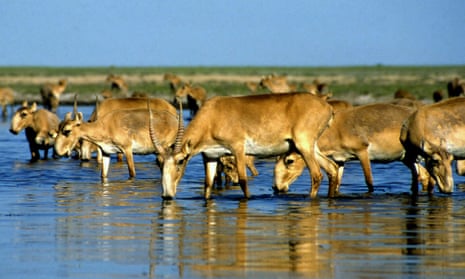Herds of one of Central Asia’s most symbolic animals, the saiga antelope, are declining rapidly – and no one knows why.
The Kazakh department for emergency situations says more than 19,000 saiga carcasses have now been buried in the country’s Qostanai region, though unofficial reports on 20 May suggested the number of dead animals may already exceed 30,000.
“It’s shaping up to be a complete catastrophe,” says EJ Milner-Gulland, a UK-based academic who heads the Saiga Conservation Alliance, a network of conservationists working to protect the antelope.
“I’m afraid the animals are still dying and we are not actually getting a final number yet,” she added. “I’m expecting that number to go up quite substantially in the coming days.”
The saiga, with its distinctive bulging eyes, tubular snout and spiralled horns, is as distinctive as it is endangered. Conservationists estimate there are 260,000 saigas in Central Asia, including 200,000 in west-central Kazakhstan.
The recent animal deaths already represents the biggest decline of the species in recent history.
Bacteria
Senior officials from Kazakhstan’s agriculture ministry and the regional governor visited the area this week to coordinate a response. So far, they’re baffled by what’s causing the deaths.
Officials say the carcasses bear no wounds or other signs of trauma that would indicate mass poaching – a problem in past efforts to maintain healthy saiga populations. Instead, they say the culprit is likely the Pasteurella bacteria – a naturally occurring bacteria that is carried in animals’ mouths and nasal passages.
Milner-Gulland says that while guess the cause of death may indeed be Pasteurella, it’s probably not the whole story. Pasteurella normally kills only weaker animals that have already been stressed or sickened by something else.
“The fact that we’re getting positive reports of Pasteurella doesn’t mean the bacterium is the underlying reason the animals are dying,” she says. “[The bacteria] is there naturally.”
Milner-Gulland is reluctant to speculate on the cause of death but says current evidence points to a highly infectious disease.

Russian rockets
This explanation is not likely to satisfy activists like Musaghali Duambekov of the Kazakh-based environmental movement Anti-Heptyl, a name that references compounds used in rocket fuel.
His group traces many of the country’s environmental problems to the highly toxic fuels used by Russian rockets launched from Kazakhstan’s Baikonur Cosmodrome.
“I think the authorities [in Kazakhstan] are hiding the real causes of the loss of the large numbers of saiga antelope every year,” he says.
“As an active member of the Anti-Heptyl movement, which has been against the [Russian] Proton rocket launches, I think the situation, among other things, is connected to the rockets, as large parts of Kazakhstan are being affected by poisonous elements on a regular basis,” Duambekov says.
Several Russian Proton-M rockets in recent years have exploded over Kazakhstan after lifting off from Baikonur, sparking concerns among local residents and environmental activists.
While it’s unclear to what extent environmental poisons like heptyl compounds might be harming animal populations, international experts say that’s probably not what’s killing off the saiga.
“I think there is no evidence to that at all,” says Milner-Gulland. “We’ll get toxicology reports from the environmental sampling that’s being taken, and that will help us to understand one way or the other.” She points out that if antelope mortality continues to spread, it will make the environmental-poisoning theory that much more untenable.
The saiga has been the victim of several mass declines over the years, reaching near-extinction in the 1920s and again in 2003 due to poaching and over-hunting. At one point in 2003, the number of live animals fell to just 21,000.
One source of hope is that the saiga has the capacity to rebound quickly from mass-mortality events. The females give birth fairly rapidly and are fertile from one year of age.
“It’s an extraordinary species,” Milner-Gulland says. “Because it lives in a really harsh environment, where you have really cold winters and drought condition, it has a natural ability to rebound.”
While Kazakhstan has the largest surviving saiga population, other significant populations are found in Mongolia and Russia’s Kalmykia Republic.

Comments (…)
Sign in or create your Guardian account to join the discussion